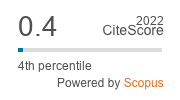Characterization of heat shock protein in red flour beetle Tribolium castaneum Herbst. (Coleoptera: Tenebrionidae)
Keywords:
Red flour beetle, Tribolium castaneum, heat shock protein (HSP), molecular chaperone, N-terminal sequencingAbstract
Red flour beetle, Tribolium castaneum Herbst. (Coleoptera: Tenebrionidae) tolerate the heat treatment in the food processing facilities and storage godowns. The anhydrobiotic character to tolerate the heat treatment of the insect is due to some special metabolites. Characterization of the insect homogenate showed that protein was one of the major constituent imparting the heat tolerance. Using SDS-PAGE (10%) analysis we could decipher the protein with molecular weight of the 70KDa (heat shock protein) act as molecular chaperone in protecting the normal protein in cells of the heat tolerant stages of the beetle. The identity of the heat shock protein (HSP) has been confirmed by the N-terminal sequencing. Further theoretical analysis of the protein sequence shows that the protein is stable and composed of four conserved domains.


